Top 20 Most Popular Foods of Angola
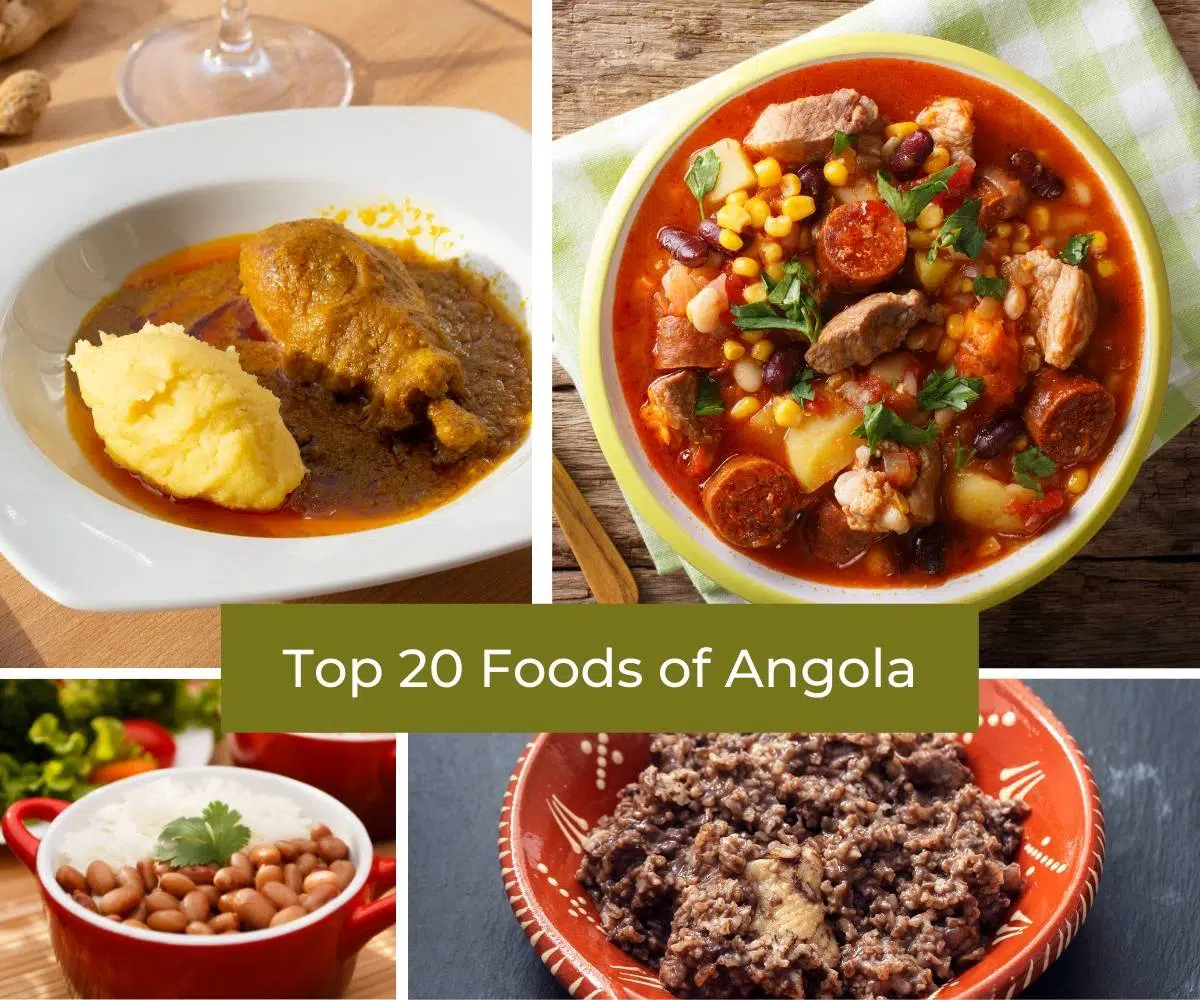
Angola is a country in Southern Africa whose varied terrain encompasses tropical Atlantic beaches, a labyrinthine system of rivers, and a Sub-Saharan desert that extends across the border into Namibia. Covering an area of 1,246,700 square kilometers, its food can vary from north to south and from east to west.
Angolan cuisine is like a delicious blend of Portuguese and Congolese flavors, thanks to its colonial history and neighboring influences. Funge takes the top spot as the favorite food, accompanied by rice, beans, and Kizaca leaves. You’ll find these tasty staples paired with many delightful dishes we’ll explore.
The most common ingredients used in the cuisine of Angola are tomatoes, garlic, palm oil, and beans. And because of the Atlantic Ocean and its vast territory, its cuisine offers a great variety of seafood and meats. Also, Angolan cuisine is known to be very saucy. Everything must have sauce so that when the meat or fish is finished, we still have the sauce to enjoy.
1. Funge
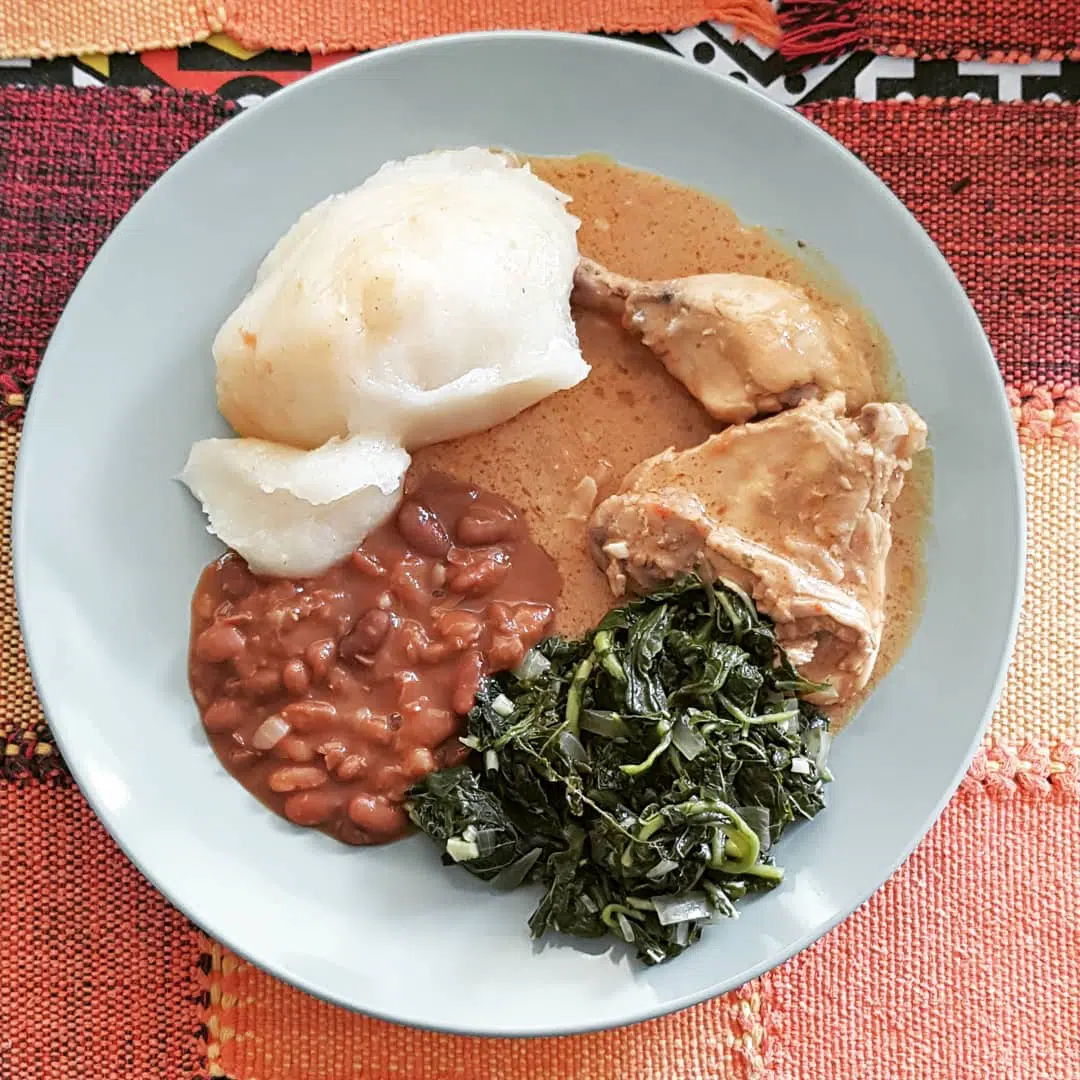
Funge is the basic dish of the Angolan diet, and it’s the most popular food in the country. It is made of Fuba (flour) of corn or cassava (yuca). The northern region of Angola eats more Funge made of cassava, and the southern part eats more Funge of corn. Some people like the mixed version too, Funge of cassava and corn.
The steps are very simple, but the process requires a little effort. The water needs to come to a boil and then the ingredients are poured into it, just like you would make mashed potatoes. You need strong arms to beat it in order to have a smooth Funge without any clumps. It is normally eaten at lunch and can be accompanied by other dishes.
2. Mufete

Mufete is the second most popular and delicious food in Angola after Funge. It is mostly eaten on the weekends at sunset because it is a little bit heavy, and after eating it people just want to relax.
The composition is very straightforward. It is a combination of beans with palm or red oil, grilled fish, boiled plantains and sweet potatoes, chopped onion, and flour (Farinha).
Mufete is usually made with Cacusso, a fish found on the shores of Luanda. Some people also add boiled cassava to it. The combination of the salty sauce of the beans and the sweetness of the sweet potatoes makes this dish very delicious. It’s one of the few Angolan dishes that is not served with Funge or rice.
3. Calulu

Calulu is a very common dish in Angolan cuisine. It can be made with fish or dried meat. It is usually served with Funge. Some people serve it with rice, but the experience is just not the same.
This is the kind of dish that people always add something to, such as spice or strong flavors, to make it unique. Calulu is essentially made of fish or meat, sweet potato leaves, tomatoES, palm oil, and onions.
4. Jimboa

Jimboa is one of the most eaten vegetables present in Angolan cuisine. Originally from the southern region of Angola, this vegetable has a few health benefits. It is rich in fiber and proteins, which help fight against fat and gain muscle mass.
It can be prepared with salt, vinegar, tomatoes, and sometimes palm oil, and then brought to a boil. It is served with Funge, Calulu of fish or meat, and frequently with beans. This is a soft dish and can be eaten at any time of the day.
5. Kizaca
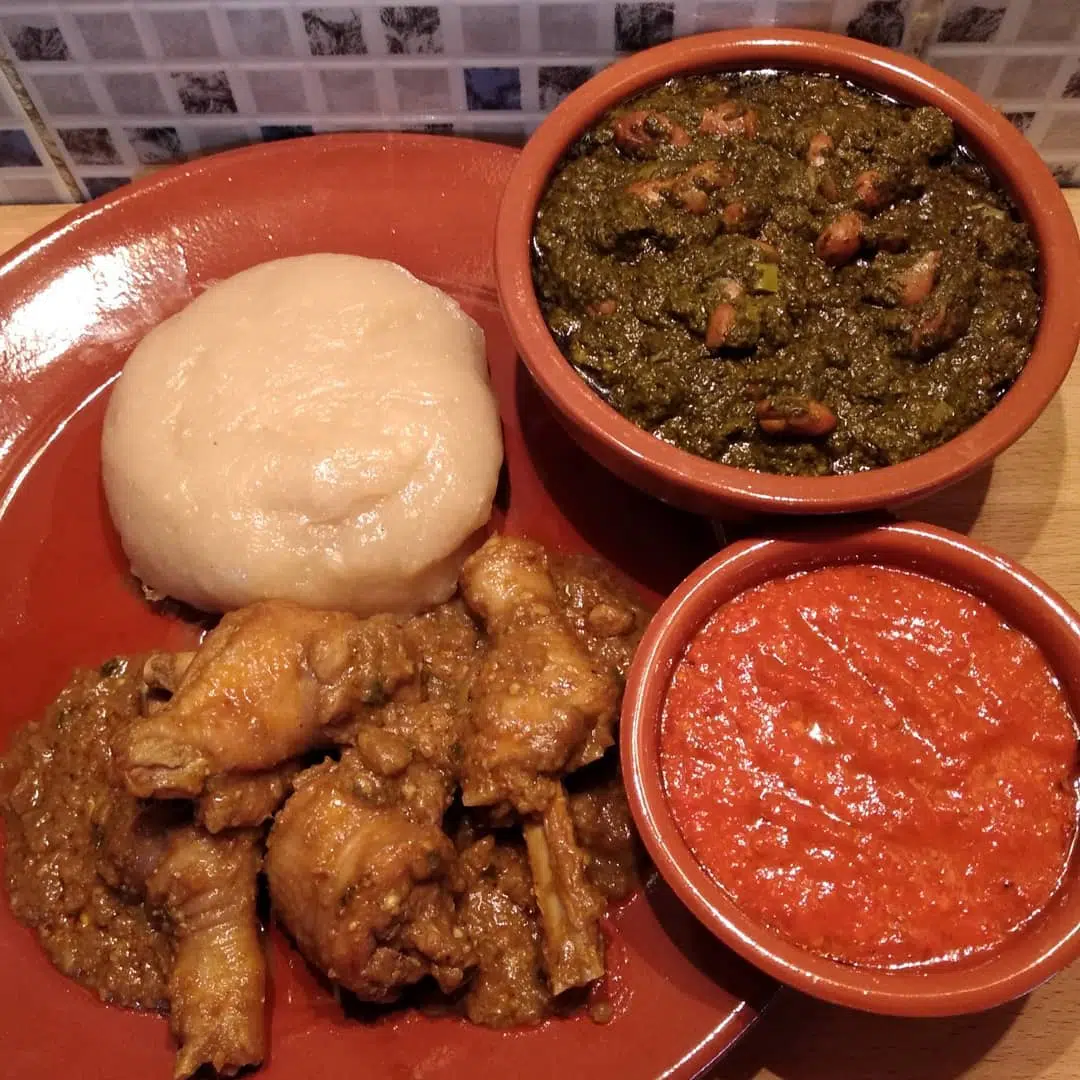
This is considered the most flavorful dish to be served with Funge. Kizaca are the leaves of cassava. It can be accompanied by fish, meat, or chicken, and it is eaten everywhere throughout the country.
It is usually boiled and seasoned with the usual ingredients, tomatoes, onions, salt, oil, and vinegar. It’s easy to prepare and very delicious.
6. Cachupa
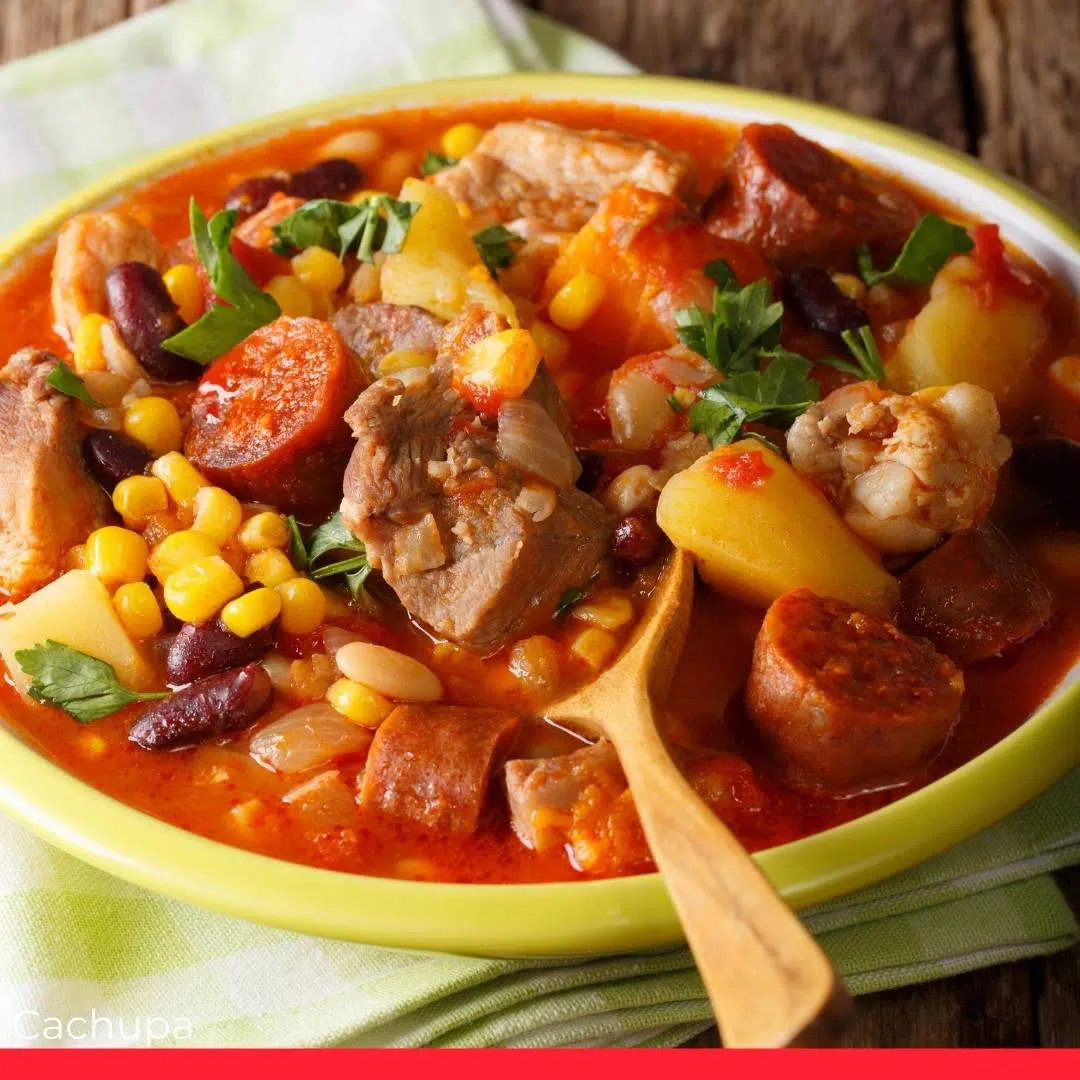
This is a hot exotic dish that originated from Cape Verde and has been adopted and modified by Angolans.
It consists of a mix of various ingredients with beans being the main one. Similar to Mufete, this one is also mostly eaten on the weekends. It is a combination of beans, beef or pork, bacon, potatoes, cassava, and cabbage. It is then seasoned with the usual ingredients. Some people add corn and sweet potatoes to it to give it a light sweet flavor.
7. Kissangua

Kissangua is a traditional homemade drink that originated in the south of Angola by the Ovimbundu ethnic group. It is originally a craft drink, but nowadays it has been produced industrially and exported to Europe. It is made with Fuba (flour) of corn, and some regions also add pineapple pulp to it and call it “Pineapple Kissangua.”
To prepare this drink, flour is put to boil, usually with 5 liters of water, so it makes a homogeneous mixture. It is then put inside a bottle and exposed to the sun for fermentation, which takes about 2 to 5 days depending on the desired percent of alcohol.
This homemade drink is very cheap to make and is usually served in traditional social gatherings. Kissangua is like the national symbol of Angola.
8. Mukua

Mukua is a fruit of the boabab tree originally from the northern part of Angola. It has a hard shell like a coconut. Inside the fruit, there are seeds that are coated with whitish powder, which is the fruit pulp. It has a unique taste and is used to make juices, mousses, and even cakes.
It is so delicious that it is now exported to other parts of the world. It is rich in vitamins and calcium, and also helps to reduce blood sugar; thus, it’s often recommended for those who suffer from diabetes.
Mukua juice can be made at home by putting the mukua in boiling water so that melts, and then adding sugar to it and letting it rest for hours.
9. Muamba of Chicken
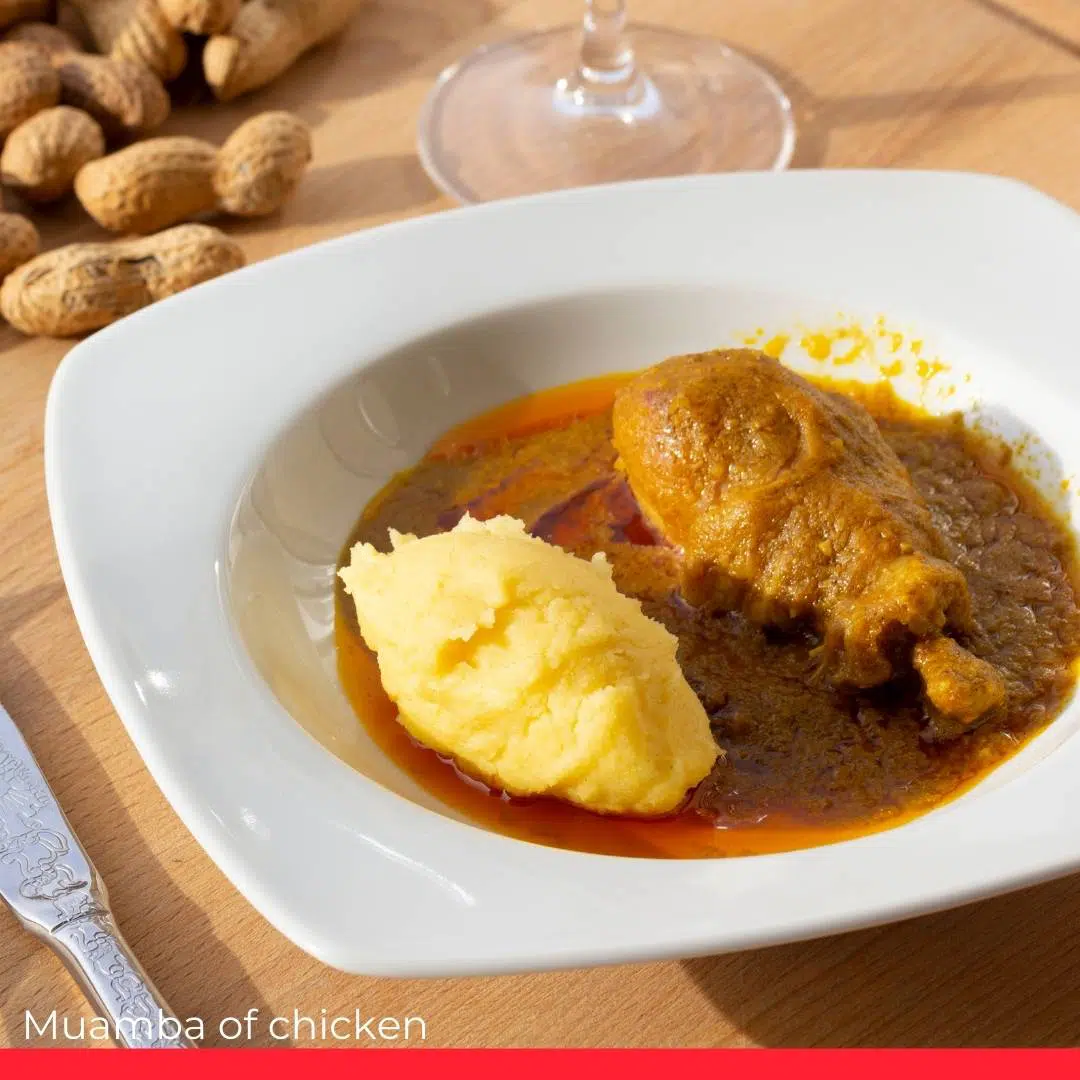
This dish is also well known in Gabon and Congo, where it is considered the national dish. Muamba of chicken consists of chicken cut in pieces with a variety of sauces.
The slow-cooked chicken is combined with okra, squash, and dendém paste. It’s cooked for one hour and is served with Funge. This stew-like dish goes very well with Funge. The strong Muamba sauce gives flavor to the very mild cassava Funge. There’s also Muamba fish, but it’s not as well known.
10. Ginguba Torrada

Ginguba means peanuts in English. It is mostly eaten as a snack and tastes very good when it is roasted (Ginguba Torrada). This is an “on the go” dish, as Angolans eat it on the streets or in the taxi while going to work or with friends. It can be served with roasted plantains or grilled cassava. It is sometimes accompanied by Kissangua or Mukua.
11. Molho de Tomate, Ovo and Chouriço

A sauce of tomato, egg, and meat sausage is a dish that is well known for being very delicious and easy to prepare. Traditionally it is made with tomato sauce, garlic, meat sausage, onion, and boiled eggs, and that’s it.
Savor the feast with Funge and delicious Mukua juice!
12. Makayabu

Makayabu is the Angolan name for dry fish. It is consumed a lot in Angola, but its origin is traced back to the Congo. The fish can be cacusso or codfish. Makayabu is often served with Funge, Kizaca, cabbage, or Calulu.
The process involves first soaking it in water for 2 hours to remove the salt, after which it can be seasoned with salt, spices, tomato, vinegar, and cooking oil.
13. Arroz com feijão – Rice and Beans

This food originated from South America and has been adopted by many countries of the world, Angola being one of them.
Angolans consume rice and beans as a base dish, second to Funge. Anywhere you go in the country, you can be served this dish. It is so popular that it is often served with traditional dishes such as Kizaca, Jimboa, or Calulu, and it also has a lot of sauce on it.
14. Bagre Fumado

Bagre Fumado is simply a dried catfish. It is extracted from the rivers of Angola and is very popular in the northern region. It is cooked with onions, salt, and tomato, and then it is either grilled or cooked. Bagre Fumado can be served with sweet potatoes, okra, or Funge.
15. Chikuanga

Chikuanga is sometimes called cassava bread because it looks like pieces of bread and is made from cassava.
The process is simple. The cassava needs to be peeled and cut into pieces. These pieces are then put into cold water where they rest for 2 days so that they become smooth and fermented. Next, it is boiled with water until it gets hard and golden, and then it is wrapped into the banana leaves. Chikuanga can be served with Mufete, Bagre Fumado, and other dishes.
16. Fumbua

Fumbua is one of the dishes that is most consumed in the northern part of Angola and the neighboring country of the DRC.
Fumbua are leaves that are collected from the forest and are very rich in vitamins. It can be found in restaurants, but it is mostly sold on the streets. It is cooked with boiling water and salt, palm oil, roasted peanuts, and seasoning. It is very flavorful, especially when served with Bagre Fumado, Chikuanga, or Funge, as shown below.
17. Muzongué or Caldo
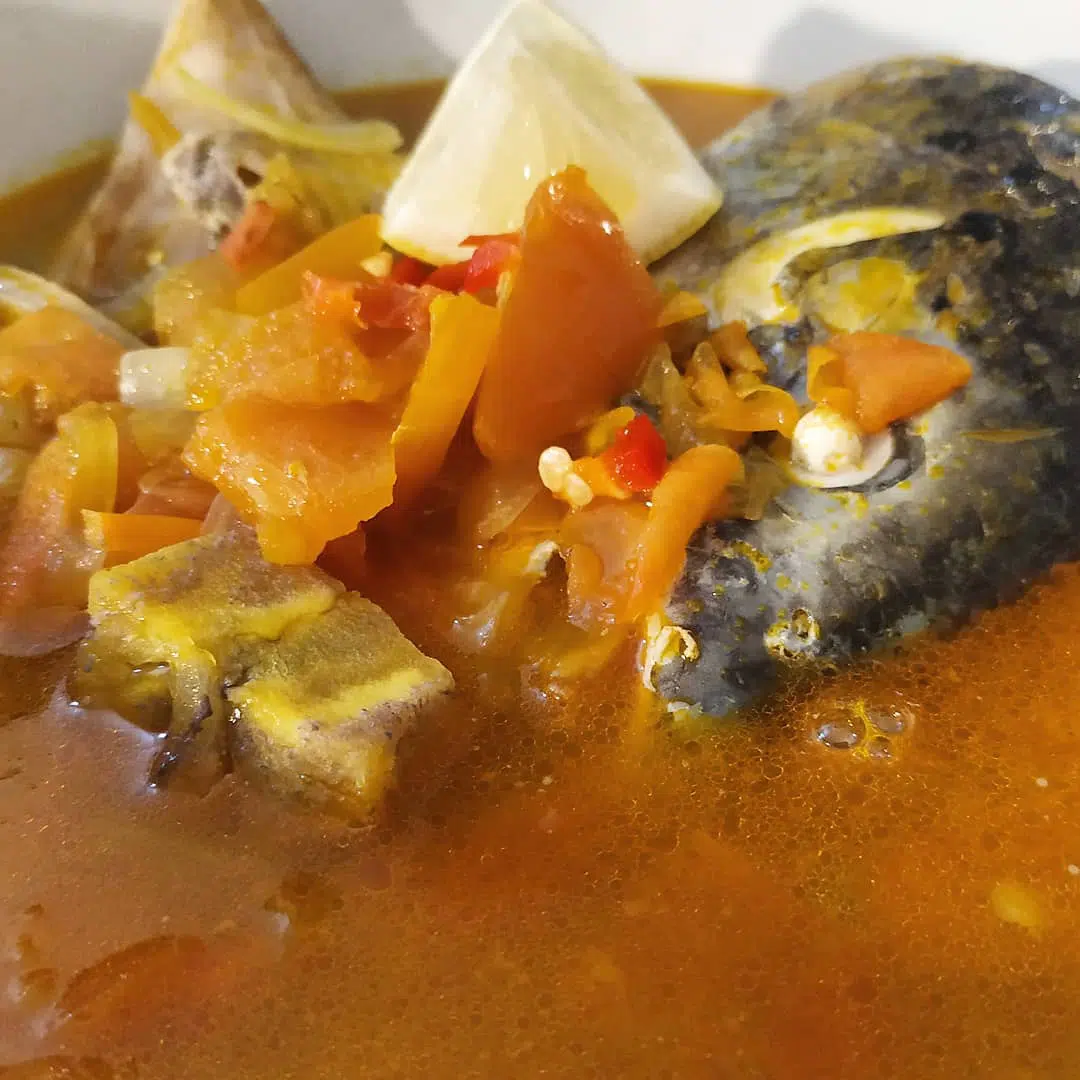
Caldo is a dish made with fresh fish. It is mostly eaten in the morning after a party or celebration because it is good for hangovers. It is simply made by cutting the fish, Cacusso, or crab into cubes, seasoning it, and then boiling it.
It is served with a combination of sweet potatoes and cassava, and red palm oil is added to it, giving it a sweet and salty flavor that fights the alcohol in the body if one is hungover. It is usually homemade and served in the mornings.
18. Cabidela

Cabidela is a Portuguese dish that has been widely adopted by Angolans. It’s typically prepared with poultry, especially chicken. The particularity of the dish is that the chicken blood is added almost at the end, mixed it with vinegar so it doesn’t clot, while the rice is boiling, much like “jugged” or “civet” dishes. The blood is taken when the animal is slaughtered and gives a brown color to the dish.
Occasionally, white rice and Funge can be served with Cabidela. Cooking with blood is an old custom common to several ancient cultures. In Angola, Cabidela may be prepared with other fowl or meat (duck, turkey, pork, kid, or game), though it’s not common. Cabidela can be eaten at restaurants, especially those located on the coast.
19. Cabrito (Goat)

Goat meat is very popular in Angolan cuisine. Goats can be found in the eastern part of the country and is also exported to nearby countries as well. It is often eaten when there is a celebration, graduation party, or even on special holidays. When there is a goat dish on the table, people forget the other meats.
It’s eaten with rice or Funge and a mix of other traditional dishes, such as Calulu, Kizaca, or Jimboa. It is cooked simply with salt, onions, and a few herbs. Some add plantains to it when eating it with rice, just to give it a slightly sweet flavor.
20. Catatos
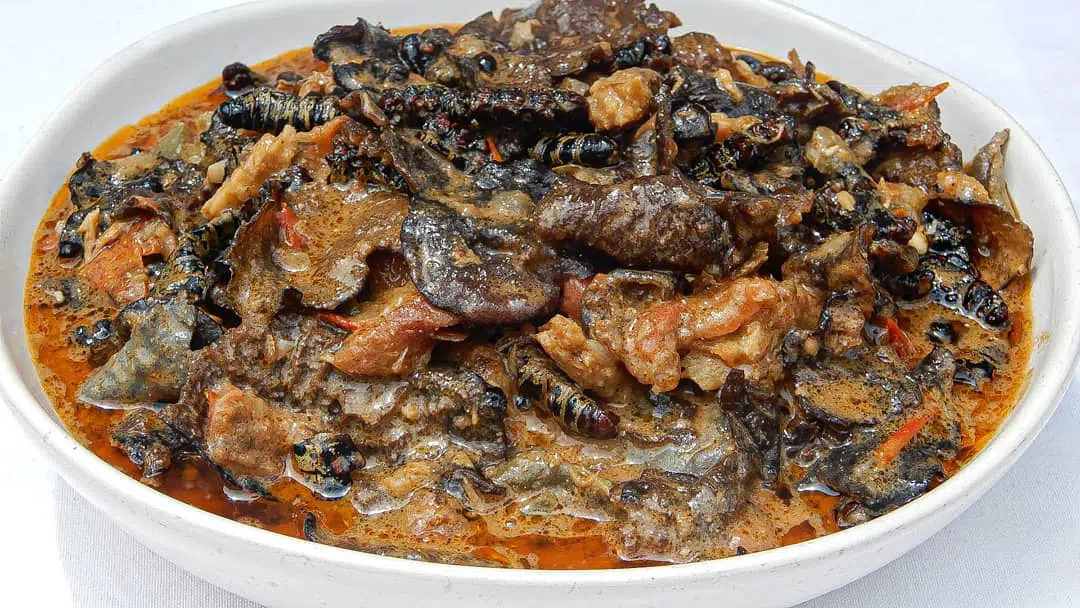
Catatos is a unique and unusual Angolan dish. At its most basic, the dish is made by frying caterpillars with garlic, but it can be enriched with the addition of onions, peppers, and tomatoes. The caterpillars should be quite tender but with a crunchy texture. Some say that they even taste like prawns.
The dish is packed with nutritional value since caterpillars have a higher amount of protein and iron than fish or beef. It is recommended to serve Catatos with rice, Funge, and hot sauce.
Related: Popular Portuguese Dishes
Related: Popular Foods in Namibia
Related: Popular Foods in Botswana
Related: Popular Foods in South Africa

This really helped with my Angola report for school!!